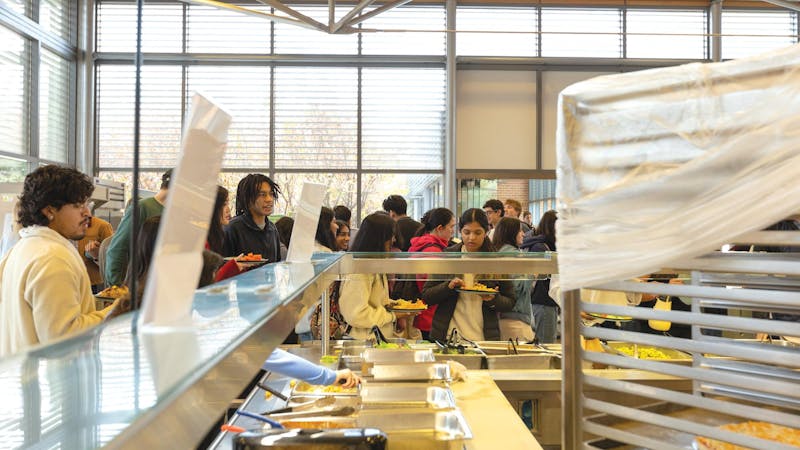Relish: Turning over Banana Leaf Malaysian
Tucked away in the corner of a freshly built shopping center, Banana Leaf Malaysian Cuisine initially seems to be just another Chinatown restaurant. Its bamboo decor and thatched-hut kitchen may be Asian kitsch, but the charming, if small, restaurant delivers fresh tastes and complex flavors.Malaysian food is a melange of Indian, Eurasian and Chinese cuisines, with curries, herbal soups and stir-fried noodle dishes. These numerous influences give a comforting glimmer of familiarity to anyone setting out to experience Malaysian cuisine for the first time, while still allowing diners the experience of exploring a new cuisine. The many hefty cultural influences shaping Banana Leaf's extensive menu are presented phonebook-style, like at many of the surrounding restaurants,. Appetizers run from $2.95 to $7.95, and while the priciest seafood dishes can weigh in at over $20, depending on market prices, the majority of the menu items are well under $10 apiece. Lunch items, available on weekdays from 11 a.m.-3 p.m., are $4.95 to $5.95.
From what we've casually observed in many Houston restaurants, the fewer Caucasians populating an Asian restaurant, the more authentic the cuisine presented. And by that rule of thumb, Banana Leaf won its first battle, as we were surrounded by many who appeared more schooled in Asian cuisines than we were. The restaurant's 10-12 large tables quickly turned over during lunchtime, as businesspeople and families talked and share dishes. The dining style is communal: Dishes are served family-style, with extra plates, utensils and bowls of rice to share. At surrounding tables, businessmen scooped extra servings of rice into the bowls of their company, and mothers delivered chunks of fish into their children's mouths with chopsticks. Diners at Banana Leaf can also peer unabashedly into the kitchen, which is visible behind clear glass - a confident decor choice, given that many eating establishments apprehensively hide their kitchens out of sight.
Many reviewers praise this visibility into the kitchen, especially when the chefs - who, according to Banana Leaf's website, are all Malaysian - prepare roti canai, an Indian pancake, which requires much dough-twirling. Unfortunately, the restaurant was not serving roti canai when we visited, so we started off with the achat: pickled mixed vegetables. The carrots, cabbage, baby corn and cucumber were served slightly chilled, with a peanut and sesame seed garnish. The vegetables, which were pickled in vinegar laced with turmeric powder and spicy herbs, were refreshingly cool and summery, with a sweet, tangy taste that left us feeling more light than full. Although we anticipated a kimchi-like dish, the Malaysian achat was definitively more tropical. The dish was slightly spicy, though: enough to make it interesting, but not overpowering.
Next, we shared the Banana Leaf Satay Chicken - marinated chicken on skewers. The chicken was pan-fried and crispy. Though its exterior was greasy, the skewered chicken didn't feel heavy, and for a dish that could have easily used inferior chicken parts, the poultry's quality was noteworthy. The peanut sauce that accompanied the chicken was a welcome break from the peanut butter-based sauces one often finds in Asian restaurants. This peanut sauce was dark and chunky, slightly sweet and slightly spicy.
So far, we were enjoying our food. Perhaps this overconfidence led us to order Bah Kitteh, a Chinese herbal soup. Maybe we should have listened to our waiter, who seemed unsure that we would enjoy the soup. The Bah Kitteh came in a large metal bowl, lit underneath with a candle - if nothing else, Banana Leaf's dishes are beautifully presented. On closer inspection, the soup - a murky gray broth - contained pork ribs, plain bones, tofu and vegetables. Unlike the two earlier, lighter offerings, the broth had a bitter, dark taste, one that was easy to appreciate, if not finish. The pork was fatty, and the tofu was passable - though who actually enjoys tofu? We gave ourselves points for being adventurous, but realized we had met our match.
Our main dish, Steamed Fish in House Special Nyonya Sauce, also embodied the tropical feel of many of the entrees. The full flounder was topped with a surprisingly rich tomato-pineapple sauce, spiked with mint leaves. The broiled fish - served with all its bones intact - was a mix of textures, depending on the part of the body from which a particular forkful was grabbed. Dense, chewy chunks were packed around the backbone, and buttery, flaky meat lined the fins. Each of the textures was properly cooked, however, and they all benefited from the dense sauce, which finished up slightly spicier than our appetizers had. The refreshing mint notes added a cool aftertaste, rendering this dish the most complex assortment of flavors we sampled.
We found the menu to be a nice assortment of tropical and pan-Asian food, certainly not too alienating even for squeamish diners. The wait staff is extremely helpful for those making an entrance into Malaysian dining, offering suggestions for other dishes and assisting confused diners not used to separating fish from the bone. The menu, which offers Malaysian food and general Asian cuisine, offers everything from fried chicken wings to the startlingly bitter Chinese herbal soup. Diners can order the unfamiliar, or settle for a tried-and-true pho noodle soup. And the price is right: For two appetizers, soup and a large fish, we paid $20 apiece. The fish entree was the most expensive, although it could have fed us twice over, and given the menu's extensive options and price range, diners could stop by during lunch or dinner for less than $10. Impressing others with your sophisticated palate, thriftily: That's what college is all about.
Catherine Bratic is a Hanszen College alumna and Sarah Rutledgeis a Martel College alumna.
More from The Rice Thresher

Over 1,000 students petition against new meal plan
When Konstantin Savvon opened the Housing and Dining email announcing the new unlimited meal plan, he was instantly concerned about the impact on off-campus students like himself.

Rice football wins season opener under new coach
For the first time since 2018, Rice football opened its season with a victory. Scott Abell was soaked with yellow Powerade following a 14-12 win on the road Saturday against the University of Louisiana at Lafayette, which won 10 games and made it to the Sun Belt Conference championship last season.

Acting like an athlete: Rice basketball alum takes on Broadway
Underneath Chadd Alexander’s Broadway costume, there’s ankle tape and wrist braces — same protective gear he wore as a walk-on basketball player at Rice, though now he’s performing eight shows a week in the ensemble of “Harry Potter and the Cursed Child” instead of running conditioning drills in Tudor Fieldhouse.

Please note All comments are eligible for publication by The Rice Thresher.